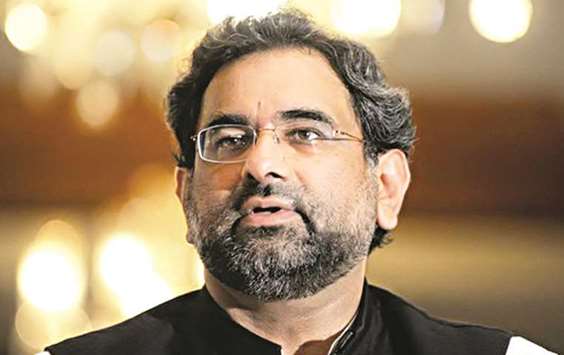Newly elected Prime Minister Shahid Khaqan Abbasi, in his maiden speech, talked about his economic vision while affirming a continuity of Nawaz Sharif’s policies.
The focus remains on expediting the ongoing development programme driven primarily by the China-Pakistan Economic Corridor.
At the centre of his discussion was the commitment to broaden the tax net by bringing every affluent individual, including those in the parliament, into it.
He was grieved at how a recent tax directory of parliamentarians showed that politicians were not working with sincerity. “Those who do not pay taxes and live a luxurious life will have to pay taxes now,” he declared.
Abbasi also appealed to the people to pay their due taxes honestly, warning that he planned stern action against tax evaders and expected the rich to contribute their share to the national economy.
With slippages on non-tax revenue and lower than targeted tax collections, the fiscal deficit over the recently concluded fiscal year has been estimated at higher than 4.2% of GDP — significantly greater than the 3.8% target set by Dar himself.
Alarmingly, with far reaching consequences, the total revenue-to-GDP-ratio has struggled to pick up.
In fact, it has plummeted to 9.4% in the first three quarters (July- March for which reconciled numbers are available) against 9.9% of GDP in the same period last year.(Data for the full year is yet to be compiled)
But that is not all; the tax revenue for the same period struggled at 8% of GDP compared to 8.3% of GDP during the same period last year.
Similarly, non-tax revenue also stood at 1.3% of GDP compared to 1.6% of last year.
This is despite the fact Finance Minister Dar had been taxing almost everything possible to increase revenues and showed improvements in absolute numbers.
The numbers show the hard earned gains, on the revenue front over the past four years, of removal of tax exemptions and purported reforms are on a reverse gear.
Such a realisation is upsetting at a time when the government is in the last leg of its tenure and unlikely to be able to show greater fiscal discipline.
It needs to be remembered that basic objective of tax reforms under the 3-year IMF programme was to expand tax base and reduce tax rates.
The government seems to have miserably failed on this count as the country has one of the highest sales tax rates at present and the tax base has not been expanded despite withdrawal of some tax exemptions.
In the process, the government changed the definition of surcharges and included them in
‘other taxes’ to show performance of the FBR and higher tax-to-GDP ratio.
Also, an attempt was made to bring the real estate sector under the effective tax net.
The agriculture and services sectors were mostly outside the effective tax net even though these were central promises of the IMF programme and the 7th National Finance Commission Award.
No wonder then the IMF recently called for the need to go for fresh taxation measures worth around 1.5% of GDP (almost Rs500bn) during the current fiscal year.
In a rather adverse opinion, the IMF noted that policy implementation had weakened and macroeconomic vulnerabilities begun to re-emerge as fiscal consolidation slowed, the current account deficit widened, and foreign exchange reserves declined.
On the structural front, the accumulation of arrears in the power sector has resumed, financial losses of ailing public sector enterprises continue to weigh on scarce fiscal resources, and exports remain low.
Despite progress, poverty and inequality are still significant, and growth needs to become more inclusive, according to the IMF.
The IMF also pointed out that tax revenues were 0.6% of GDP lower than expected, due to lower collection of sales tax including those through oil products, direct taxes, excises, and gas infrastructure development cess (GIDC). In addition, non-tax revenues were 0.7% of GDP lower than anticipated, due to lower SBP profits, PSEs’ dividends, and disbursements under the Coalition Support Fund.
The IMF “advised that significant additional tax policy and administrative measures of around 1.5% of GDP may be needed to achieve the FY 2017/18 revenue objective, especially if this fiscal year’s (2016-17) revenue turns out lower than expected”. The FBR has stood behind its collection target by Rs260bn by end of fiscal year although final numbers are still being reconciled.
The new tax measures in run up to next year’s budget and elections could include further reducing tax expenditures (estimated at 1.3% of GDP in 2016/17), gradually raising petroleum taxes (the easiest route), further strengthening the system of withholding taxes for non-filers, and improving provincial tax collection in agriculture, property, and services.
These measures should be complemented by continued strong administrative efforts to improve tax compliance.

Shahid Khaqan Abbasi

